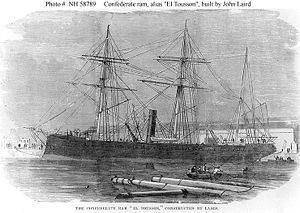Name HMS Scorpion Laid down April 1862 Launched 4 July 1863 | Ordered 1862 Completed 10 October 1865 Construction started April 1862 Builder Cammell Laird | |
 | ||
Fate Sunk as target 1901Refloated 1902; sold for scrapFoundered 17 June 1903 | ||
HMS Scorpion was an ironclad turret ship of the Royal Navy, built by John Laird Sons & Company, at Birkenhead. She was one of two sister ships secretly ordered from the Laird shipyard in 1862 by the Confederate States of America. To conceal her true ownership, all concerned endorsed the fiction that she was being constructed as the Egyptian warship El Tousson. She was to have been named North Carolina upon delivery to the Confederates. The British government seized the pair of ironclads in October 1863, a few months after their launch and before they could be completed.
Contents
Design and description
Wivern and her sister were intended, together with other warships, to break the Federal blockade of Confederate coastal cities and to hold some Northern cities for ransom. The ships had an length between perpendiculars of 224 feet 6 inches (68.4 m), a beam of 42 feet 4 inches (12.9 m), and a draught of 17 feet (5.2 m) at deep load. They displaced 2,751 long tons (2,795 t). The hull was divided by 12 watertight bulkheads and the ships had a double bottom beneath the engine and boiler rooms. Their crew consisted of 152 officers and ratings.
The Scorpion-class ships had two horizontal direct-acting steam engines, built by Lairds, each driving a single propeller shaft, using steam provided by four tubular boilers. The engines produced a total of 1,450 indicated horsepower (1,080 kW) which gave the ships a maximum speed of 10.5 knots (19.4 km/h; 12.1 mph). The ships carried 336 long tons (341 t) of coal, enough to steam 1,210 nautical miles (2,240 km; 1,390 mi) at 10 knots (19 km/h; 12 mph). They were barque-rigged with three masts. The funnel was made semi-retractable to reduce wind resistance while under sail.
No ordnance had been ordered by the Confederates before the ships were seized in 1863, but in British service they mounted a pair of 9-inch rifled muzzle-loading guns in each turret. The guns could fire both solid shot and explosive shells. According to Parkes, going from full depression to full elevation supposedly took one hour in smooth water and with an even keel!
The Scorpion-class ships had a complete waterline belt of wrought iron that was 4.5 inches (114 mm) thick amidships and thinned to 3 inches (76 mm) at the bow and 2.5 inches (64 mm) at the stern. It completely covered the hull from the upper deck to 3 feet 3 inches (0.99 m) below the waterline. The armour protection of the turrets was quite elaborate. The inside of the turret was lined with .5 inches (12.7 mm) of iron boiler plate to which T-shaped beams were bolted. The space between the beams was filled with 10 inches (254 mm) of teak. This was covered by an iron lattice .75 inches (19.1 mm) thick that was covered in turn by 8 inches (203 mm) of teak. The 5.5-inch (140 mm) iron plates were bolted to the outside using bolts that ran through to the interior iron "skin". The area around the gun ports was reinforced by 4.5-inch plates to give a total thickness of 10 inches. The turret roof consisted of T-shaped beams covered by 1-inch (25 mm) iron plates.
Construction and career
In early 1864, the Admiralty purchased both for the Royal Navy and named them Scorpion and Wivern. Commissioned in July 1865, Scorpion was assigned to the Channel Fleet until 1869, with time out for a refit that reduced her sailing rig from a bark to a schooner. In late 1869, she moved to Bermuda for coast and harbour defence service. Scorpion remained there for over three decades before being removed from the effective list. Scorpion was sunk as a target in 1901 but raised the next year and sold in February 1903. She was lost at sea while under tow to the U.S., where she was to be scrapped.
